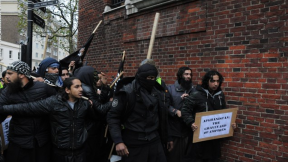
After parents, teachers are those who interact the most with Muslim youth on a regular basis. They must be on the front lines of not only identifying when a young Muslim is facing the challenge of anger and the danger of reacting to it the wrong way, but they must also be part of the solution to this problem.
Below are six tips that can help:
1. Recognize the signs
Organize a teachers’ workshop at your school about youth violence and anger. Have a professional youth counselor, psychologist and psychiatrist present on this issue. One of the key topics should be how teachers can recognize the signs even before any violence happens.
2. Hire a good guidance counselor
If your school does not already have one, encourage the administration to hire at least one professionally qualified and experienced guidance counselor. These experts are your allies in helping students deal with challenges outside of academics, whether that is family breakup, facing prejudice and discrimination, bullying or other issues. If your school can afford it, consider hiring more than one person for this job.
If money is an issue, then consider asking a youth counselor, psychologist or psychiatrist to volunteer for this position some days a week in exchange for some kind of benefit from the school (e.g. discounted tuition in the case of a private school).
3. Incorporate anger management into your curriculum
While teachers have more than enough material to cover during the year, devote a few lessons to the topic of anger management. More effective will be incorporating it into existing material. For instance, in a discussion about Abraham Lincoln, don’t just give basic information about his life and accomplishments. Point out that he faced tremendous difficulties as a young person and an adult, yet he overcame these varying adversities and channeled his pain into making America a better nation for everyone and an example for the world.
4. Establish after school classes, activities and programs
Keeping youth busy in the right kinds of activities is key. That’s why after school programs that offer them outlets for healthy development, whether that is sports, a school newspaper or yearbook, or any type of group that aims to channel their energy into making a positive difference around them are so critical. If such alternatives are not offered, they may direct their frustration or anger toward the wrong outlets.
5. Incorporate Islamophobia into classroom materials and discussions
Prejudice and discrimination are usually topics covered in social studies classes. Discussion in the American context normally focuses on racism against African-Americans and anti-Semitism, for example. Use this opportunity to talk about Islamophobia as well. This will not only introduce students to this new form of intolerance, but it will show them that prejudice and discrimination are hardly a thing of the past. Rather, they remain a problem that must be dealt with even today.
6. Include books and other material about Islamophobia in your classroom and school libraries
This will allow all students to read more about this new phenomenon, thereby encouraging them to recognize it and challenge it. Some suggested books include My Name is Bilal by Asma Mobin-Uddin and The Color Blind Boy by Mohammed Yaseen for younger kids. For older ones, Islamophobia: Making Muslims the Enemy by Peter Gottschalk and Gabriel Greenberg shows how this form of prejudice is manifested in political cartoons.
Also for the middle school and high school level, the audio report Which One of These is Not Like the Others, featured on NPR’s program This American Life, should definitely be part of any discussion or homework on this topic. It recounts the ordeal of a Palestinian-American Muslim girl in an unnamed small town in the United States who faces painful prejudice because of her faith. It also highlights the repercussions on her and her family because of it.








Add new comment